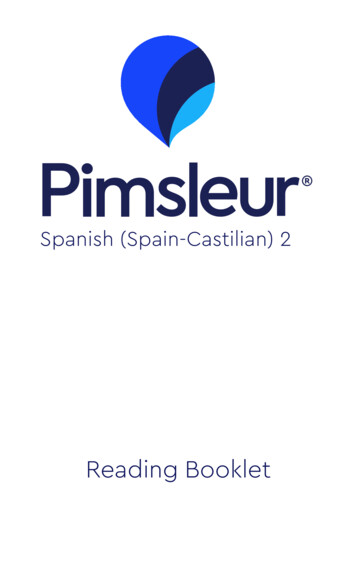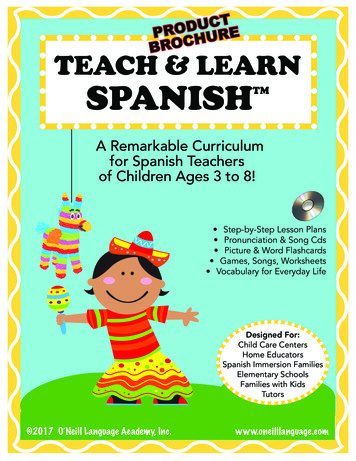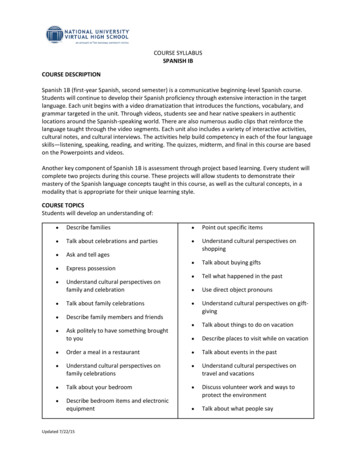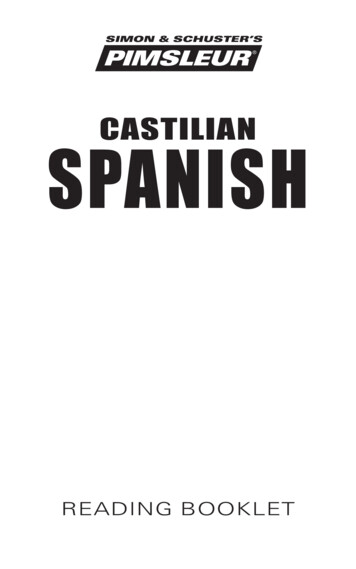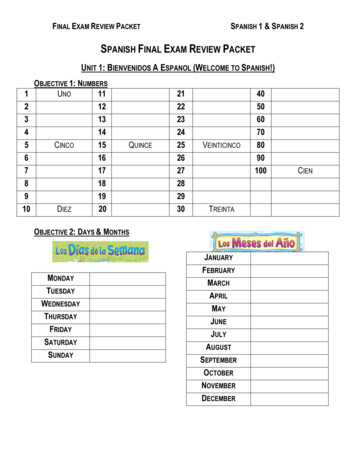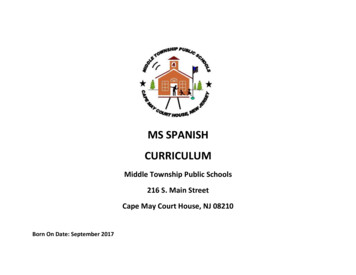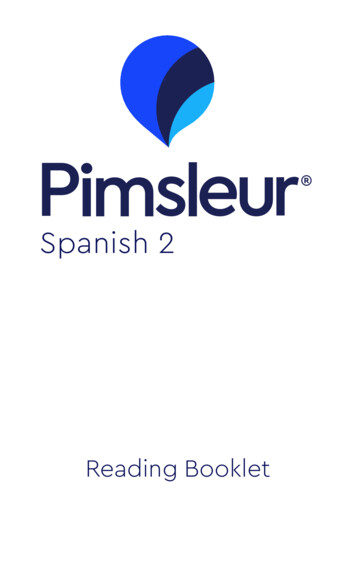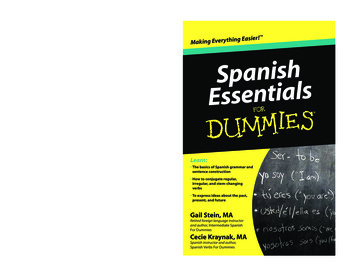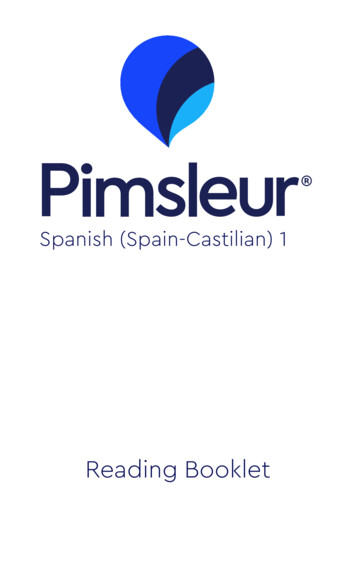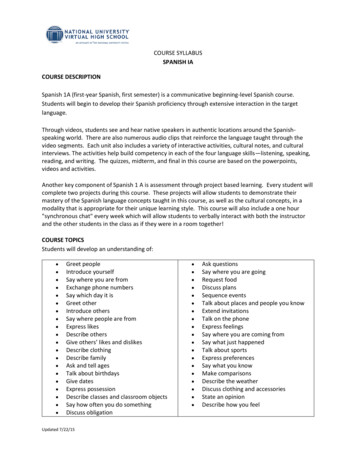
Transcription
COURSE SYLLABUSSPANISH IACOURSE DESCRIPTIONSpanish 1A (first-year Spanish, first semester) is a communicative beginning-level Spanish course.Students will begin to develop their Spanish proficiency through extensive interaction in the targetlanguage.Through videos, students see and hear native speakers in authentic locations around the Spanishspeaking world. There are also numerous audio clips that reinforce the language taught through thevideo segments. Each unit also includes a variety of interactive activities, cultural notes, and culturalinterviews. The activities help build competency in each of the four language skills—listening, speaking,reading, and writing. The quizzes, midterm, and final in this course are based on the powerpoints,videos and activities.Another key component of Spanish 1 A is assessment through project based learning. Every student willcomplete two projects during this course. These projects will allow students to demonstrate theirmastery of the Spanish language concepts taught in this course, as well as the cultural concepts, in amodality that is appropriate for their unique learning style. This course will also include a one hour"synchronous chat" every week which will allow students to verbally interact with both the instructorand the other students in the class as if they were in a room together!COURSE TOPICSStudents will develop an understanding of: Greet peopleIntroduce yourselfSay where you are fromExchange phone numbersSay which day it isGreet otherIntroduce othersSay where people are fromExpress likesDescribe othersGive others’ likes and dislikesDescribe clothingDescribe familyAsk and tell agesTalk about birthdaysGive datesExpress possessionDescribe classes and classroom objectsSay how often you do somethingDiscuss obligationUpdated 7/22/15 Ask questionsSay where you are goingRequest foodDiscuss plansSequence eventsTalk about places and people you knowExtend invitationsTalk on the phoneExpress feelingsSay where you are coming fromSay what just happenedTalk about sportsExpress preferencesSay what you knowMake comparisonsDescribe the weatherDiscuss clothing and accessoriesState an opinionDescribe how you feel
Talk about schedulesAsk and tell time Say what is happeningLEARNING OUTCOMESStudents will be able to: See and hear Spanish spoken by native speakers in a variety of natural language settings.Practice listening to, reading, speaking, and writing Spanish.Practice pronunciation skills by recording and listening to their own voice and comparing it tothe voices of native speakers.Begin to develop their ability to communicate effectively and express themselves withconfidence in Spanish.Have the opportunity to enhance their awareness of, and appreciation for, the diversity of theSpanish-speaking world.Gain cultural knowledge about various Spanish-speaking countries.Have a sense of control over, and responsibility for, their learning process.Have the opportunity to develop a sense of class membership, using the Internet tocommunicate with the instructor and other classmates.Increase their awareness of the Web as an educational and informational resource.PRE-REQUISITES / CO-REQUISITES NonePrimary Text:This course is not text dependentSupplementary Materials:NotebookSupplies for course project (will vary)COURSE METHODOLOGYThis is an inquiry-based course where you will discover and utilize knowledge of Spanish language viathe lectures, videos, and other readings, and class discussions with other students and the instructor.Updated 7/22/15
Acting as a facilitator, your instructor will guide you through the process; however, as the learner, youare responsible for actively acquiring and constructing knowledge by completing all assigned readingsand activities.Both formal and informal assessment will be used in evaluating your performance throughout thecourse. Informal assessment will include an evaluation of the quality and timeliness of your participationin class activities. Formal assessment will involve multiple-choice quizzes, written essays, major writingassignments, a midterm, a final exam and a course project.COURSE PARTICIPATION OBJECTIVESThis course for which you are registered is a college preparatory, academically rigorous course thatcovers a semester’s worth of material . As such, it is important that you adhere to the followingguidelines as you manage your time and commit to successfully completing all required coursework:1. The requirements for this course are equivalent to completion of minimum of 90 hours of classinstruction at a traditional on-site high school.2. Assignments must be submitted for each unit as they are completed so that the teacher mayreview and assess your performance. Do not hold your work, you must submit each unit’shomework as it is completed, demonstrating weekly assignment completions.3. You participate regularly in your course to demonstrate not only continued participation, butalso completion of all course requirements, including assignments, assessments and classdiscussion forums.4. You must complete your individual work and any incident of suspected cheating, plagiarism orcollaboration on assignments violates the academic integrity expectations outlined at the timeof your enrollment and can result in failure of the course or further action as deemedappropriate.COURSE OUTLINESpanish 1AUnitUnit Summary1Greet people, introduce yourself,classroom directions, numbers,time, body parts, alphabet, thingsin classroom, calendar events,weather conditions, season.Updated 7/22/15Assignments / ActivitiesVocabulary IntroductionVocabulary QuizLecture: Introducing yourself to others and farewellsLecture: Using genderLecture: Spanish alphabetLecture: Tu vs. Usted
Presentation: En la classeClassroom Commands ActivityIntroduction to the Course ProjectAssignment 1Interactivities: Spanish names Los numerous El cuerpo La sala de classes El calendario El tiempoExtra Practice Numbers 1-100 Weather Telling Time Months Body Parts Days of the Week Saludos/GreetingsClass Discussion Learning Styles Assessment Tu vs. Usted Punctuation and accent marks2talk about activities you like anddon’t like to do, ask others whatthey like to do, understandcultural perspectives on favoriteactivities Grammar-infinitive,negatives, expressing agreementand disagreement ConnectionsMusic Language explorationcognates Pronunciation: Thevowels a, e, and i Spanish in ourcommunity.Unit 1 QuizVocabulary IntroductionVocabulary QuizLecture: Infinitives (-ar, -er, and –ir)Lecture: GustarLecture: Negatives—expressing agreement anddisagreementLecture: CognatesLecture: VowelsLecture: Popular Dances of the Spanish Speaking WorldAssignmentInteractivities:Updated 7/22/15
InfinitivesNegativesAgreement and disagreementExtra Practice Verb infinitives Los cognados Affirmatives and Negatives—oppositesClass Discussion: Family Album Project Infinitives, cognates, and negatives Gustar Speaking and Listening activityUnit 2 Quiz3personality traits, ask/tell whatpeople are like, use adjectives todescribe people, understandcultural perspectives onfriendship Grammar-adjectives,definite and indefinite articles,word order ConnectionsLiterature Language explorationcognates that begin with es- consonant Pronunciation- thevowels o and u Spanish in thework force. School schedules andsubjects, what students do duringthe day, ask and tell who is doingan action, compare your schoolwith a student in a Spanish –speaking country Grammarsubject pronouns, present tenseof – ar verbs Connectionsconnections between Latin,English, and SpanishPronunciation- the letter cSpanish in the communityVocabulary IntroductionVocabulary QuizLecture: AdjectivesLecture: Definite and indefinite articlesLecture: Adjective placementAssignment 1Interactivities Articles Adjective agreement Placement of adjectivesExtra Practice Adjectives Definite and indefinite articlesClass Discussion Family Album Project Adjectives and translation exercise Definite and indefinite articles and translationexercise Word order exercise Speaking and listening activityBenchmark AssessmentUpdated 7/22/15
Vocabulary IntroductionVocabulary QuizLecture: PronounsLecture: Present-tense of –ar verbsAssignment 2Interactivities: Subject pronouns practice Practice with –ar verbsClass Discussion Family Album Project Spanish words Subject pronouns Express doing an action Speaking and listening activity Writing your class scheduleExtra Practice Subject pronouns Ar verbsUnit 3 Quiz4Describe a classroom. indicatewhere things are located, talkabout more than one object orperson, and understand culturalperspectives on school.Grammar-the verb estar, theplurals of nouns and articlesConnections- mathematicsLanguage exploration- languagethrough gesture Pronunciation.Vocabulary IntroductionVocabulary quizLecture: EstarLecture: NounsAssignmentInteractivities Vocabulary PracticeClass Discussion Conjugating Estar Locations Nouns Speaking and Listening activityExtra PracticeUpdated 7/22/15
5Talk about foods and beveragesfor breakfast and lunch, talkabout likes and dislikes, expresshow often something is done andunderstand cultural perspectiveson meals. Grammar-presenttense of –er and –ir verbs, megustan, and me encantanConnections- History Languageexploration- using a noun tomodify another noun.EstarPluralsMidtermVocabulary IntroductionVocabulary QuizLecture: -er and –ir verbsLecture: Me gustan, me encantanLecture: Using a noun to modify another nounAssignmentInteractivities -er and –ir verbs Gusto and encantaClass discussion Speaking and Listening activity La comida favoriteExtra Practice -er and –ir irregular verbs Te gusta o te encanta?6Talk about foods and beveragesfor dinner, describe what peopleor things are like, discuss food,health, and exercise choices andunderstand cultural perspectiveson diet and health. Grammar-theplurals of adjectives, the verbser.Unit 5 ExamVocabulary IntroductionVocabulary QuizLecture: Plural of adjectivesLecture: Verbs Ser and EstarAssignmentInteractivities Practice with plurals of adjectives Practice with SerExtra Practice Review units 1-6Class Discussion Translations Using SerUpdated 7/22/15
78to talk about locations in theircommunity, discuss leisureactivities, talk about where theygo and with whom, learn how toask questions and understandcultural perspectives on leisureactivities. Grammar-the verb ir,asking questions Connectionsorigins of the Spanish days of theweek Pronunciation- stress andaccents Spanish in thecommunityTalk about what they like anddon’t like, how to tell time, -ir infinitives, “jugar,” leisureactivities common in LatinAmerican culture, famousHispanic athletes, finish courseprojectsUsing Ser to tell timeBenchmark ExamVocabulary IntroductionVocabulary QuizLecture: Verb –irLecture: Stress and accentsLecture: Asking questionsLecture: Origins of the Spanish Days of the WeekAssignmentClass Discussion Conjugating the verb –ir Asking questions Speaking and Listening ActivityUnit 7 ExamVocabulary IntroductionVocabulary QuizLecture: Me gustariaLecture: A que hora?Lecture: --ir a infinitiveLecture: The verb jugarLecture: Leisure activities in the Spanish speaking worldLecture: Famous Hispanic AthletesAssignmentClass DiscussionSpeaking and Listening ActivitiesFinal Exam9Course ProjectUpdated 7/22/15Submit Final Course ProjectAll students are required to complete a course project andit is recommended that students work on their courseprojects each week. The final project will be due at the endof the course.
COURSE PROJECT OPTIONSSPANISH 1AStudents will choose one project from the list below:1. Family Album Project: As part of the online Spanish 1A class you will create a "familyalbum" to be presented the last week of class. The main objective for this project is toallow you to demonstrate what you have learned this semester through Spanishdescriptions of family members. This album should be in a format that allows forpresentation to the online class. Power point is one option that would allow for easy onlinepresentation, but you may come up with something more creative also! The main idea isthat 6 pictures can be displayed with detailed written captions in Spanish. If you have anidea other than power point, simply double check with your instructor to make sure that itwill work. (For example, you could create a "video" album, where you narrate in Spanishwhile video taping the family member. You could also create a website where each linkgoes to the picture and information of a different family member.)2. Cultural Information Project: This project is designed to allow you to investigate a culturaltopic in the Spanish speaking world that interests you. The final product will be a 6 slidepower point presentation (this is the only project in English) that presents the topic of yourchoice with key information and appropriate pictures that help explain the topic. The firstslide will be a title page that states your name and topic. The sixth slide will contain all ofthe sources that you have gathered and used basically a bibliography page. Make sureyou give specific web addresses for any websites used. All remaining slides must containkey information that clearly explains the chosen topic. Pictures should be incorporated tohelp the viewer understand and visualize the topic presented. (For example, a slidepresentation on Ballet Folklorico could include pictures of typical costumes, pictures ofperformances, and a map of where it is performed. Feel free to go beyond simple pictures– an audio clip would help this presentation with a sample of traditional music used inballet folklorico, or even a digital video clip of an actual performance!) Through the postingof these projects in week 6 to the "Cultural Information Project" thread in the DiscussionBoard, all of the students in the class will be able to learn about the topic that you present.ACADEMIC HONESTYThe following are forms of academic dishonesty. These practices will not be tolerated.Plagiarism: Plagiarism consists of using another author's words without properidentification and documentation of that author. Plagiarism takes the form of directquotation without the use of quotation marks and/or documentation, or paraphrasingwithout proper identification and documentation. The fabrication of sources, or the act,deliberately or unconsciously, of passing another author's work off as your own are alsoconsidered to be plagiarism.Updated 7/22/15
Falsification: Falsification consists of deliberately changing results, statistics, or anyother kind of factual information to make it suit your needs. It also consists ofdeliberately changing a source’s intent by misquoting or taking out of context.Multiple submission: If you wish to turn in the same work or use the same research, inwhole or in part, for more than one course, you must obtain permission to do so fromall instructors involved. Failure to obtain this permission constitutes academicdishonesty. This course is a chance for you to explore your own creativity.GRADING POLICYFinal Grades for this class will be based on your performance, participation in all class activities, groupdiscussions, unit assignments, course projects, and benchmark exams.Grading ScaleLetter GradeAAB BBC CCD DDFPercentage Earned95% 90% - 94%87% - 89.9%84% - 86.9%80% - 83.9%77% - 79.9%74% - 76.9%70% - 73.9%67% - 69.9%64% - 66.9%60% - 63.9%59% and lowerHOW YOU WILL BE GRADEDGradeSkillsADemonstrates excellence in grasping key concepts; critiques the work of others; providesample evidence of support for opinions; readily offers new interpretations of discussionmaterial.BShows evidence of understanding most of the major concepts; is able to agree or disagreewhen prompted; is skilled in basic level of support for opinions; offers an occasionaldivergent viewpoint.Updated 7/22/15
CHas mostly shallow grasp of the material; rarely takes a stand on issues; offers inadequatelevels of support.D or FShows no significant understanding of material.CLASS DISCUSSION RUBRICInitial PostsScoreInitial Response3Responsecompletelyaddresses theprompt with awell--‐developedparagraph of atleast fiveto sevensentences.2Responseadequatelyaddresses theprompt with aparagraphof five toseven sentences.1Responsesomewhataddresses theprompt with aparagraphless than five tosevensentences.0ResponseDoes notAddress theprompt.OrNo response.Responses to ClassmatesScoreFollow-up posts2Responses areThoughtful and creatediscussion.1Responses only agreeOr disagree with noThoughtful discussion.And:One response givento two classmates.And/or:Only one response toOne classmate.0No response given*If there is more than one prompt, students must reply to all prompts. All prompts are worth a total of 5points. Scoring is detailed above.SCHOOLWIDE LEARNER EXPECTATIONSNUVHS students will be Engaged LearnersCritical ThinkersEffective CommunicatorsGlobal CitizensUpdated 7/22/15
Updated 7/22/15
SPANISH IA COURSE DESCRIPTION Spanish 1A (first-year Spanish, first semester) is a communicative beginning-level Spanish course. Students will begin to develop their Spanish proficiency through extensive interaction in the target language. Through videos, students see and hear native speakers in authentic locations around the Spanish-speaking .

